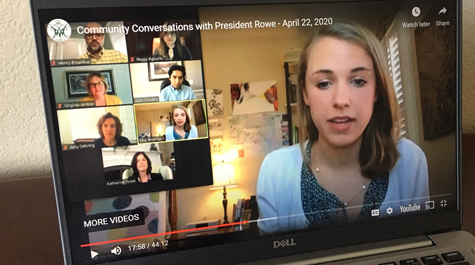W&M focused on minimizing long-term financial impact of COVID-19
The immediate financial impact of COVID-19 on William & Mary has been substantial, and the university is exploring ways to “flatten the curve” in an effort to minimize long-term consequences.
“In the short term, we’re anticipating, between now and fall, a $13-$32 million hit in terms of foregone revenue or unintended expenses,” said Vice President for Finance & Technology Amy Sebring during the latest installment of President Katherine A. Rowe’s community conversation series, which is being streamed online every Wednesday at noon through May 13.
Sebring said the university is working to minimize its expenditures and focusing on things that are mission critical, “because any dollar we save today gives us a buffer as we look into the future.” Among other things, the university has instituted a hiring freeze, filling only positions that are required to maintain continuity of operations. For the remainder of the fiscal year, employees have been asked to curtail all purchases not considered “mission critical,” with the exception of externally funded research and expenses.
Rowe’s community conversation focused on how the university is grappling with big questions and big decisions during the COVID-19 pandemic. She was joined by Sebring, Provost Peggy Agouris, Vice President for Student Affairs Ginger Ambler, Vice President for Strategic Initiatives and Public Affairs Henry Broaddus and student leaders Ellie Thomas ’20 and Abhi Chadra ’20.
Sebring explained why the university decided to provide rebates to students for housing and dining after campus closed in March.
“We were trying to recognize that students weren’t going to get the benefit of the housing and dining programs for the remainder of the semester,” Sebring said. “We were also trying to make sure we were covering the university’s obligations.”
The panel of guests spoke about the thought processes of past decisions, as well as considerations for the future. For example, Agouris said the university intends to hold in-person classes in the fall as long as it is safe to do so.
“We are rigorously planning right now for the next year, and we’ll have more information and details by June,” Agouris said.
The admission office approached its transition in much the same way faculty members pivoted to delivering course content online, Broaddus explained.
“We had to think about how to approach the month of April virtually, and I think a really important pivot early on was made by recognizing that our goal was to never recreate programs; it was to generate connections,” Broaddus said.
Ambler said input from students provided the motivation to move Commencement for the Class of 2020 to the weekend of Oct. 9-11, 2020. From the students’ feedback, Ambler and her team knew they wanted a celebration that was distinctive and joyful.
“It was the students who said they wanted to preserve those main traditions for when we can be back together again,” Ambler said. “That’s really important to us.”
 Skip to main content
Skip to main content

